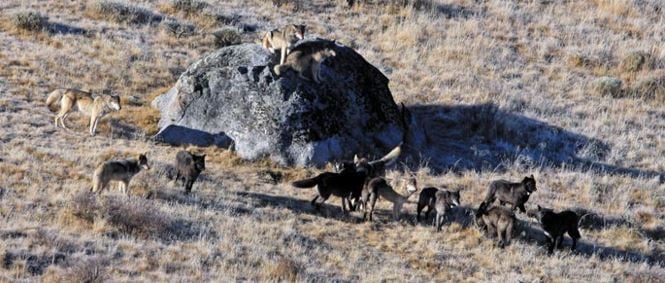By YELLOWSTONE NATIONAL PARK NEWS SERVICE
(Yellowstone National Park photo)
YELLOWSTONE NATIONAL PARK -
Yellowstone National Park recently released their
annual wolf and bird project reports along with a three-year report on
fisheries science.
The goal of the reports is to track long-term trends that provide the scientific community with relevant information about the overall health of the Yellowstone ecosystem.
All three reports, published by the park’s Yellowstone Center for Resources with support from the Yellowstone Park Foundation and the Yellowstone Association, help inform resource management decisions and support ongoing and future research needs.
Highlights from these reports include:
- Wolves, 2014: There were at least 104 wolves in 11 packs, including nine breeding pairs, living primarily in Yellowstone National Park during December 2014.
From 2009 to 2014, wolf numbers have fluctuated between 83 and 104 wolves, and six to nine breeding pairs.
Pack size in 2014 averaged nine wolves. Forty pups survived to year-end, including 17 in northern Yellowstone and 23 in the interior of the park.
For the first time, the size of a wolf pack was estimated via genetic sampling methodology, using scat samples from a den site.
- Birds, 2014: During 2014, Yellowstone National Park continued its long-term core bird monitoring program for the 31st year and completed the fourth year of the Yellowstone Raptor Initiative, a five-year project focusing on the role of aerial predators (hawks, eagles, and owls).
Peregrines in the park continue to be highly successful and abundance remains stable, although nesting success has remained at or below the 27-year average in six of the last 10 years.
In contrast, nesting success of bald eagles and ospreys has been above the long-term averages for both species during the last several years.
- Fish, 2012-2014: There are signs that the number of Yellowstone cutthroat trout in Yellowstone Lake is increasing. Efforts to reduce the population of non-native lake trout have resulted in the removal of over one million lake trout from Yellowstone Lake. Successes with Arctic grayling and westslope cutthroat trout restoration efforts are also described as part of the native fish preservation effort.
The reports are available here:
- http://www.nps.gov/yell/naturescience/wolves.htm
- http://www.nps.gov/yell/naturescience/birdreports.htm
- http://www.nps.gov/yell/planyourvisit/fishreports.htm
In the coming month, the Yellowstone Center for Resources will release an issue of Yellowstone Science dedicated to grizzly bear research in the Greater Yellowstone Ecosystem.
The issue will present recent findings on dietary preferences and the response of bears to changing food resources, demographics of the current greater Yellowstone bear population, bear habituation to people in national parks, information on grizzly range expansion, cub adoption observations, and the risk of a bear attack.
source
The goal of the reports is to track long-term trends that provide the scientific community with relevant information about the overall health of the Yellowstone ecosystem.
All three reports, published by the park’s Yellowstone Center for Resources with support from the Yellowstone Park Foundation and the Yellowstone Association, help inform resource management decisions and support ongoing and future research needs.
Highlights from these reports include:
- Wolves, 2014: There were at least 104 wolves in 11 packs, including nine breeding pairs, living primarily in Yellowstone National Park during December 2014.
From 2009 to 2014, wolf numbers have fluctuated between 83 and 104 wolves, and six to nine breeding pairs.
Pack size in 2014 averaged nine wolves. Forty pups survived to year-end, including 17 in northern Yellowstone and 23 in the interior of the park.
For the first time, the size of a wolf pack was estimated via genetic sampling methodology, using scat samples from a den site.
- Birds, 2014: During 2014, Yellowstone National Park continued its long-term core bird monitoring program for the 31st year and completed the fourth year of the Yellowstone Raptor Initiative, a five-year project focusing on the role of aerial predators (hawks, eagles, and owls).
Peregrines in the park continue to be highly successful and abundance remains stable, although nesting success has remained at or below the 27-year average in six of the last 10 years.
In contrast, nesting success of bald eagles and ospreys has been above the long-term averages for both species during the last several years.
- Fish, 2012-2014: There are signs that the number of Yellowstone cutthroat trout in Yellowstone Lake is increasing. Efforts to reduce the population of non-native lake trout have resulted in the removal of over one million lake trout from Yellowstone Lake. Successes with Arctic grayling and westslope cutthroat trout restoration efforts are also described as part of the native fish preservation effort.
The reports are available here:
- http://www.nps.gov/yell/naturescience/wolves.htm
- http://www.nps.gov/yell/naturescience/birdreports.htm
- http://www.nps.gov/yell/planyourvisit/fishreports.htm
In the coming month, the Yellowstone Center for Resources will release an issue of Yellowstone Science dedicated to grizzly bear research in the Greater Yellowstone Ecosystem.
The issue will present recent findings on dietary preferences and the response of bears to changing food resources, demographics of the current greater Yellowstone bear population, bear habituation to people in national parks, information on grizzly range expansion, cub adoption observations, and the risk of a bear attack.
source



No comments:
Post a Comment